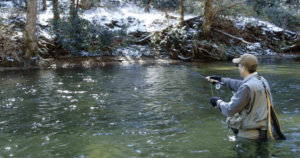Winter Fishing Tips and Tricks from Georgia DNR
from The Fishing Wire

Fishing is good in Georgia in winter
Whether you’re fishing for largemouth bass on Ocmulgee WMA or brown trout in the Chattahoochee River, fishing in the cooler months is relatively the same for any fish species. You’ll want to fish a smaller bait with a slower action. Fish are cold-blooded, so cooler water temperatures make them lethargic. Cooler temperatures will also slow their metabolism so they don’t feed as often or on as large of prey.
Bait and Action
You’ll need to consider the type of bait you will be using. Many food sources available in the spring and summer months aren’t in the winter. Frogs, grasshoppers, and leeches aren’t seen much during winter, so fishing with these lures will be unnatural to the fish. The same goes for fishing stream fish with larger dry flies. For stream fish try using small midge and nymph flies behind split shot weights. Drop them behind strike indicators so you can tell when you get a strike. On lakes and rivers, use lures that resemble crayfish or small baitfish such as minnows and shad. Soft plastics like small plastic worms, skirted jigs, and tube baits can be successful if fished slowly and patiently. The hardest part about fishing with artificial bait in the winter is slowing your action down to a crawl. If you think you are fishing too slow then you’re close to the speed that will get a response from your target. Live bait works well because it will move naturally with the water conditions. Minnows and shad will move slowly and provide their own action same as a nightcrawler or red wriggler. This way you don’t have to worry as much about bait size and action.
Location, location, location!
No matter what you choose to fish with, you have to know where these fish are going to be when the water temperature drops. You can use the perfect bait with marvelous presentation but it wouldn’t matter if you can’t put it in front of a fish. You might have heard of the term “turn over”. This is when the warm water on the surface gets cold in the fall and winter. This water then falls to the bottom and the bottom layer rises to the top “turning over the lake”. After this process, the deeper water will now be warmer than the surface. Fish will hang out in this warmer water in the deeper parts of the lake or pond where you are fishing. Try casting over deep spots where there are changes in the structure of the lake bottom, such as a ledge or hump. Any change in structure along with cover like a dock or weed bed can make great habitat for holding fish. This is where fish finder and hydrographic maps come in real handy. They make it generally easy to find the structure/cover combination you are looking for. Shallow, muddy water can also be a reservoir hotspot as the water warms and attracts baitfish. In streams, look for the deepest and slowest pools that provide slow-moving trout and bass a refuge from floods and predators.
Fishing is a fun pastime that many people enjoy, but it can seem frustrating if you don’t catch anything. These tips will get you closer to fish you’d like to have strike the other end of you line when the weather gets cold and breezy. If you’re looking for new spots or somewhere close to home, the GA DNR has public fishing areas all across the state. You can find your new fishing hole here: http://georgiawildlife.com/allpfas. The Wildlife Resources Division’s weekly fishing blog, https://georgiawildlife.wordpress.com/category/fishing/, is also a great site for timely tips and the latest fishing “hotspots,” even in the cold weather!